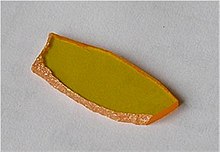Zinc selenide

| |

| |
| Names | |
|---|---|
| Other names
Zinc selenide
Stilleite | |
| Identifiers | |
3D model (
JSmol ) |
|
| ChemSpider | |
ECHA InfoCard
|
100.013.873 |
| EC Number |
|
PubChem CID
|
|
| UNII | |
CompTox Dashboard (EPA)
|
|
| |
| |
| Properties | |
| ZnSe | |
| Molar mass | 144.35 g/mol |
| Appearance | light yellow solid |
| Density | 5.27 g/cm3 |
| Melting point | 1,525 °C (2,777 °F) |
| negligible | |
| Band gap | 2.82 eV (10 K) |
Refractive index (nD)
|
2.67 (550 nm) 2.40 (10.6 μm) |
| Structure | |
Zincblende (cubic)
| |
a = 566.8 pm
| |
| Tetrahedral (Zn2+) Tetrahedral (Se2−) | |
| Thermochemistry | |
Std enthalpy of (ΔfH⦵298)formation |
−177.6 kJ/mol |
| Hazards | |
| GHS labelling: | |
  
| |
| Danger | |
| H301, H331, H373, H410 | |
| P260, P261, P264, P270, P271, P273, P301+P310, P304+P340, P311, P314, P321, P330, P391, P403+P233, P405, P501 | |
| Related compounds | |
Other anions
|
Zinc oxide Zinc sulfide Zinc telluride |
Other cations
|
Cadmium selenide Mercury selenide |
Except where otherwise noted, data are given for materials in their standard state (at 25 °C [77 °F], 100 kPa).
| |
Zinc selenide is the
eV at 25 °C (77 °F). ZnSe occurs as the rare mineral stilleite, named after Hans Stille
.
Synthesis and properties
ZnSe is available in both hexagonal (
close packing
motifs, hexagonal vs cubic.
Cubic ZnSe is produced by treatment of an aqueous solution of zinc sulfate with hydrogen selenide:[1]
- ZnSO4 + H2Se → ZnSe + H2SO4
Heating the cubic form gives hexagonal ZnSe.
An alternative synthesis involves heating a mixture of zinc oxide, zinc sulfide, and selenium:
- 2 ZnO + ZnS + 3 Se → 3 ZnSe + SO2
It is a wide-bandgap semiconductor of the
P-type doping is more difficult, but can be achieved by introducing gallium
.
Applications
- ZnSe is used to form II-VI diode lasers. It emits blue light[dubious].
- ZnSe doped with μm.[2]
- It is used as an infrared optical material with a remarkably wide transmission wavelength range (0.45 μm to 21.5 μmantireflection or beamsplitting optical coatingsare generally employed.
- ZnSe activated with tellurium (ZnSe(Te)) is a scintillator with emission peak at 640 nm, suitable for matching with photodiodes. It is used in x-ray and gamma ray detectors. ZnSe scintillators are significantly different from the ZnS ones.
Reactions
ZnSe is insoluble in water, but dissolves in concentrated hydrochloric acid.
It can be deposited as a thin film by
MOVPE
and vacuum evaporation.
References
- ^ F. Wagenknecht; R. Juza (1963). "Zinc (II) Selenide". In G. Brauer (ed.). Handbook of Preparative Inorganic Chemistry, 2nd Ed. Vol. 2pages=1078. NY, NY: Academic Press.
- NPLvia archive.org
- ^ "Institute for Single Crystals - Materials and Products - AIIBVI - Passive Laser Optics Elements". iscrystals.com. Retrieved 2016-12-28.
External links
- Coherent Optical Data optical data & more
- University of Reading, Infrared Multilayer Laboratory optical data
